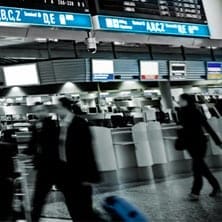
Improving the efficiency of Airport Check-In is a key concern for our clients. Not only affecting and improving passenger experience, introducing new technologies at Check-In can also reduce capacity issues and increase time spent at retail and F&B outlets for passengers. This is a valuable advantage for any airport wishing to grow profits.
How can airports reduce congestion and waiting times at Check-In?
There are several areas of new technology that aim to improve flow through Check-In:
- Auto Check-in. These self-service options allow passengers to check-in at their own convenience when they reach the airport. Reducing the demand on manned desks, also allows airports and airlines to spread the peaks and troughs of passenger arrivals over a long period of time.
- Online Check-in. Taking advantage of mobile technology and an increasingly digital world enables passengers to check-in prior to arrival at the airport. This not only speeds up the process but also reduces the number of manned and auto check-in desks required.
- Early Bag Stores (EBS). By temporarily and efficiently storing bags to accommodate early check-ins or baggage transfers until they are required for loading onto the aircraft, airports can increase operational efficiencies, profit margins. The process allows them to track baggage automatically and reduce the number of lost bags.
- Hold Baggage Screening (HBS). Complete integration between the conveyor system and the X-ray screening machines, all bags are scanned on route without stopping the bag flow. Again, this brings major operation efficiencies for airports, reducing lost bags and improving the passenger experience.
- Auto baggage build. Airports can improve efficiency and reduce staffing levels by using automated or semi-automated manual handling devices such as robots to build ULDs ready for the aircraft.
Benefits of new technology
Passenger satisfaction is crucial for an airport’s reputation. With passenger numbers increasing, and their demands growing with them, it is important that airports invest in new technology to satisfy customer requirements. As passengers now control many aspects of their lives online and at their own pace, the facilities available at Check-In must reflect this.
Introducing new technology, especially in baggage systems, reduces the space required for baggage check-in and improves operational performance. By using EBS and the related automation, both airlines and airports are able to streamline the process at Check-In, track baggage automatically reduce the number of lost bags, and therefore improve passenger satisfaction, operational efficiencies and profit margins.
There is also another important benefit for airports. Easing the flow of passenger traffic from check in to the gate, reducing congestion and the peaks and troughs that traditionally accompany airport life allows more retail time for passengers. Less time for passengers in queues means more time in coffee shops, retail outlets and restaurants. This is obviously of great benefit to airports, counting on retail rents as a source of income.
To find out more about new technology for Check-In and Hold Baggage Systems, download our free whitepaper.

